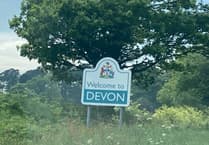Autumn is a time for farewells and for welcomes. For months our garden has been brightened by the fuchsia hedge we planted many years ago. The drooping flowers, like ballet-dancers, dressed in red and royal-purple, seem to blossom for ever. We first fell in love with fuchsia hedges while on our honeymoon in south-west Ireland. There were miles and miles of fuchsia hedges as we travelled through counties Cork and Clare and Kerry. Now, in November, the flowers one by one begin to fall.

Is fuchsia an Irish plant? No. Like Paddington, it came from South America. The first member of this group of plants to be found was described by a French friar and herbalist, Charles Plumier. He found it while he was living in what is now called Haiti in the year 1697. He named it after one of his heroes, Leonhart Fuchs. Fuchs was born in Bavaria in about 1501 and was one of the earliest scientific botanists, producing books with beautiful woodcut illustrations. Five hundred years later we have members with his family name living in Devon. Werner and Win Fuchs spent all their married life in the South Hams and are buried in Buckland Tout Saints churchyard. Their sons and daughter still live in the South Hams. I wonder if they are descendants of that early botanist, after whom all Fuchsias are named?
Over the next hundred years about a hundred different species of Fuchsias were identified, mostly in South America. In the very south, along the coasts of Argentina and Chile the commonest species was identified as Fuchsia magellanica. This was brought to Britain, from near the Straits of Magellan, in the nineteenth century and a few varieties of it began to be planted in western Ireland and Scotland from about 1850. In Chile and Argentina it is pollinated by humming-birds but in Britain it does not seem to set seed, although bees come to take pollen. It has spread only slowly by suckering.
It became very popular as a hedging plant in western Ireland and Scotland and sometimes in Devon and Cornwall in the nineteenth century. A hundred and fifty years later those hedges are still surviving. The one Barbara and I planted is only fifty years old. Whatever their age they are beautiful. As the first frosts arrive and the last fuchsia flowers begin to fall, I say, “ Farewell Fuchsia magellenica, until next summer.” Wouldn’t Fuchsia magellenica be a good stage-name for a ballet-dancer?
Last week-end it was the date for the monthly estuary bird count. I always look forward to it; I help Paul Rossiter count the Salcombe Harbour section. He welcomed me with the news that he had been visited by up to six Black Redstarts, flitting around the roof-tops near where he lives.. Ones and twos are regular around Kingsbridge and along our coast at this time of the year but six all visible at the same time is exceptional. I looked up my copy of ‘The Birds of Devon’ by Michael Tyler. The largest group recorded there was, “Mainly singly although four have been seen at Buckfast, Okehampton and Chagford and five at Lynton on 10th November 1982.” So, Paul’s count looks like a record.
After we had finished our count at Salcombe, we waited by the houses in Kingsbridge, where he had seen the Black Redstarts. After a few minutes a bird appeared on a roof-top. It was about the size of a robin; it shivered its red tail and flitted up onto the chimney pot and back to the roof, never staying long in one place. There weren’t six of them but this one was the first Black Redstart I had seen for several years and was so welcome.

In the summer Black Redstarts can be found nesting all over Europe and across parts of Asia but they have never been a common breeding bird in Britain. There may be only about forty pairs nesting here each year, mostly in the built up areas around London. In the autumn, Black Redstarts in the northern parts of Europe migrate south and west. This is when we see most of them; October and November are the peak months. Some stay in Devon and Cornwall for the winter, some move on southwards into France. The few ringing recoveries show that our visitors may have bred in Holland or Belgium.
They have a cousin, the so called Common Redstart, which nests in and around woods in hilly areas like Dartmoor, choosing holes in old trees for their nest sites. The Black Redstart chooses very different habitats. It seems to have an aversion for trees or bushes. It prefers rocky places or buildings with plenty of bare ground around them, so it is often seen around built up areas. After the Second World War, numbers of breeding Black Redstarts soared in London and other cities like Plymouth, which had suffered bombing raids.
With his camera, Paul took these first-class photos of both the female (or it could be a young bird of either sex for they look the same) and this handsome male with his black plumage and white patch on the wing. I hope at least some of these welcome visitors stay around for Christmas.






Comments
This article has no comments yet. Be the first to leave a comment.